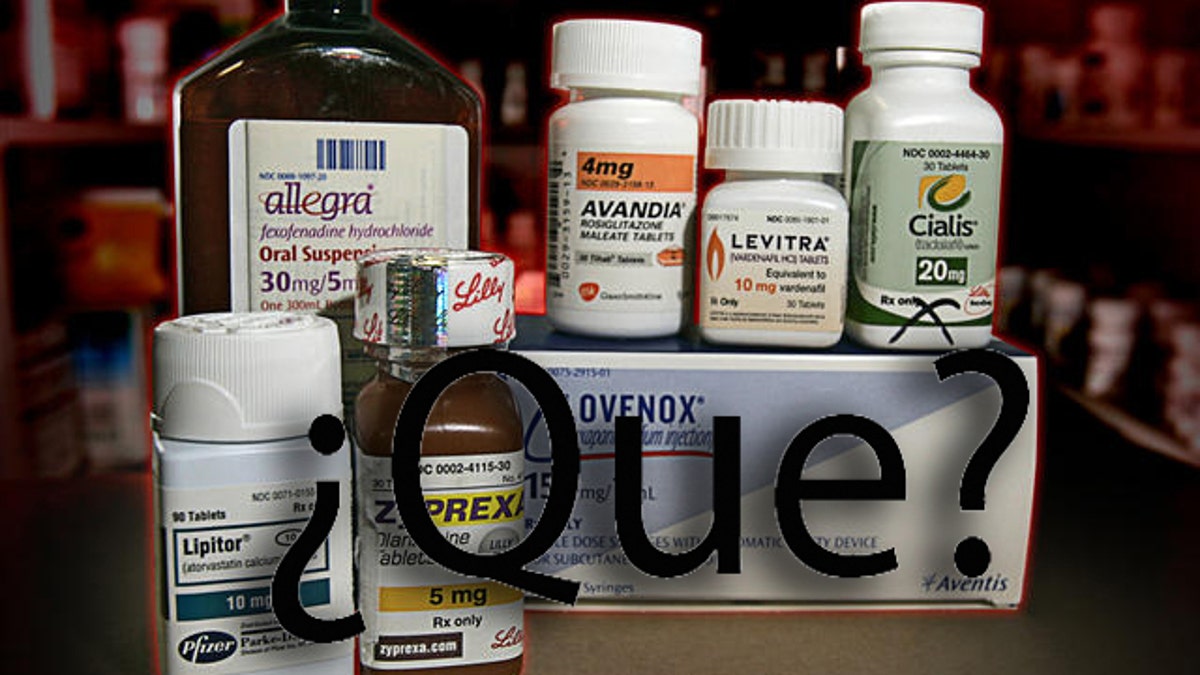
A selection of prescription drugs, including Allegra, Zyprexa, Levitra, Cialis and Lipitor are shown in an Indianapolis pharmacy, Wednesday, Jan. 9, 2008. Drug companies often delve into a weird science that ties symbolism to letters or prefixes when they hunt for the next hot brand name. They spend millions to drum up a well-known name like Lipitor while hoping to avoid the fate of Ayds, an unfortunately named appetite suppressant that saw sales sink once AIDS entered the public consciousness. (AP Photo/Michael Conroy) (AP2008)
When an elderly patient asked Isabela to hand her three tablets, the home health attendant froze.
The patient had read the label, which had been translated from English to Spanish, and it instructed her to take three tablets every time she took the medicine. Isabela, who did not want her last name used, knew from experience – and a phone call to the doctor confirmed her hunch – that the correct instruction should have been to take one tablet three times a day.
The medication label, it turns out, had been wrongly translated.
Because most states don’t require pharmacies to provide translated materials or verbal counseling to non-English speakers, Spanish speakers picking up their prescriptions may be one dose away from disaster.
Even pharmacies that do translate prescriptions may be providing faulty information. Commonly used computer programs that translate prescription labels had an overall error rate of 50 percent, according to a study of the software programs used by Bronx pharmacies released in 2010.
Some phrases simply were not translated, according to researchers. Those include descriptions such as “dropperfuls,” “apply topically,” “for 7 days,” “for 30 days,” “apply to affected areas,” “with juice,” “take with food,” and “once a day.” Other phrases, such as “once a day,” were incorrectly translated to “eleven times a day.”
According to the study, one garbled prescription label translated to:
"Take 1.2 aldia give dropperfuls with juice eleven to day."
“It scares the heck out of me that people are still thinking (the software) is effective,” said Dr. Charles Lee, who is developing a new program that he says will more accurately translate prescriptions. “They don’t know it’s not good enough for patients, but from [a pharmaceutical] perspective it’s helping them comply with requirements.”
Lee’s software, called Meducation, was developed with a grant from the National Institute of Health. It is already being used at Costco’s in New York state.
He and other software companies are trying to raise the bar of translational services. In Lee’s case, he used translators to check translations. His software also includes video demonstrations accessible in a pharmacy or in a patient’s home to show them how to take their medications.
But Dr. Iman Sharif, who led the New York study that initially reported the inaccuracies in the software that generates the prescription labels, said just because a more accurate translational tool might exist does not mean it will be employed widely – or that customers with limited English will have more accurate instructions.
“People should know they have the right to demand that kind of service,” said Sharif, who conducted the study while at Montefiore Medical Center in the Bronx but is now at Nemours A.I. DuPont Hospital for Children in Wilmington, Delaware. “Only when consumers demand it will it work. If we all check the box [that says we decline counseling] and walk away from the pharmacy then nobody cares, everybody is happy.”
Laws Tackling Prescription Labeling
While many states require translational services in hospitals and clinics, only California and New York City have similar requirements in pharmacies. Other states, including Washington state, are working on adopting similar legislation.
New York City enacted the law, which affects chain pharmacies with more than four locations, following a discrimination complaint four years ago by immigrant advocacy groups. Activists who paved the way for the law to be passed in New York City are currently behind a bill that would expand the requirement to the rest of the state.
Make the Road New York and New York Lawyers for the Public Interest, the advocacy groups who did the groundbreaking work in New York City, did a follow-up statewide survey recently to see if the major chain pharmacies were complying with local law and a settlement agreement.
They reported that nearly half of all surveyed pharmacies still couldn’t report being able to provide translated labels and nearly 30 percent could not give oral counsel to customers.
“What we found was the main gap was that the [company] administration might have some idea of how to provide services to their limited English customers but that was not necessarily trickling down to the frontline staff,” said Nisha Agarwal, Director of Health Justice for New York Lawyers for the Public Interest.
Of all major pharmacies Fox News Latino contacted, only CVS responded to explain their policies regarding services for non-English speaking customers.
According to spokesman Michael DeAngelis, CVS trains their employees to use a telephone translation service that can translate up to 150 different languages, and in New York state include warning labels and directions for usage in other languages.
Regardless of the strides made by a few pharmacies in a few locations, there is still a lot of work yet to be done, some say.
“Folks are not getting the language services that they need,” said Theo Oshiro of Director of Health Advocacy and Support Services for Make the Road New York. “They are not able to take their medicines or are hurting themselves because they don’t understand the language that is used.”
Until pharmacies become more reliable in their translations and interpretation becomes more widely available, people like Isabela take matters into their own hands.
“I always tell my friends and my family to be careful,” Isabela said. “I tell them to ask questions and make sure they understand how to take the medication.”
Soni Sangha is a freelance writer based in New York City.
Follow us on twitter.com/foxnewslatino
Like us at facebook.com/foxnewslatino
